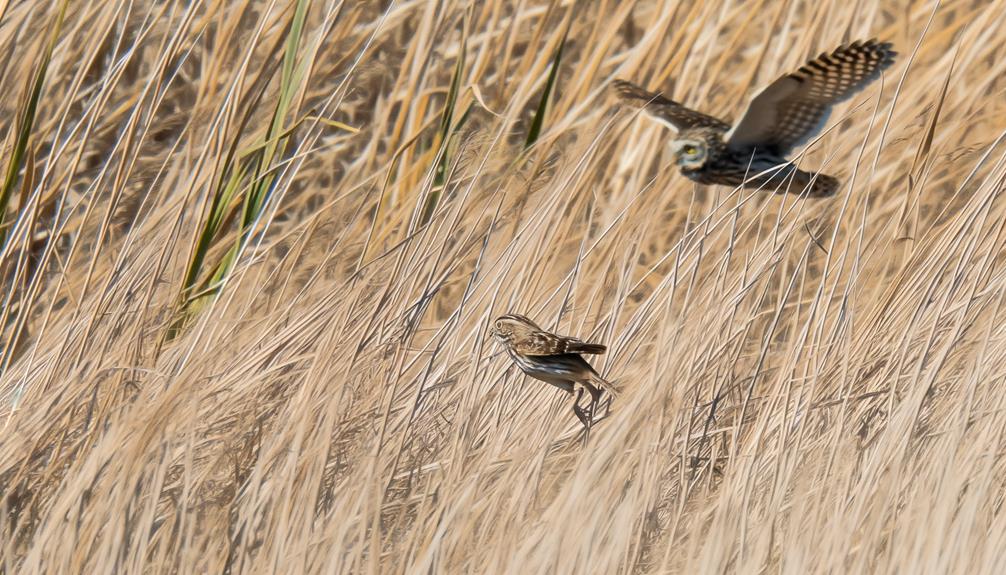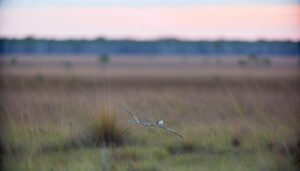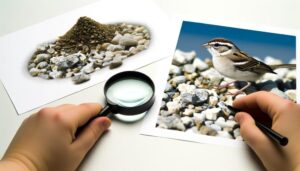How Does the Savannah Sparrow Protect Itself from Becoming Prey?
Savannah Sparrows skillfully protect themselves from predators using various techniques. They employ natural camouflage, with their plumage blending into their surroundings effectively.
They distract predators by feigning injury and emitting loud calls. Often, they lead predators away from their nests or build decoy nests.
Among their deceptive tactics, they use mimicry, visually and audibly to mislead predators. Group safety enhances their protection while their nesting habits offer additional security.
Their evolutionary adaptations include cryptic plumage, agile flight abilities, strategic feeding times and high-pitched songs. Venturing further into Savannah Sparrows' survival tactics reveals fascinating insights.

Key Takeaways
- Savannah Sparrows camouflage with their surroundings using their plumage coloration and by staying still to reduce visibility.
- They use distraction tactics like feigning injury and emitting loud calls to divert predators away from their nests.
- Savannah Sparrows practice mimicry and deception, using visual and auditory techniques to confuse or mislead predators.
- They maximize safety in numbers, practicing collective defense and utilizing the dilution effect to confuse predators.
- Savannah Sparrows have evolved survival strategies such as agile flight abilities, high-pitched songs, and feeding habits at dawn and dusk when predators are less active.
Understanding Savannah Sparrows
In our exploration of Savannah Sparrows, we quickly discover these little birds are a fascinating species, boasting a richly streaked, tan and white plumage that provides natural camouflage in their preferred grassland habitats.
These sparrows, smaller than a typical songbird, are unique regarding their physical attributes, behaviors, and ecological functions. They've got a short, notched tail and a small, rounded head with a petite beak perfect for their seed-based diet. Their song, a series of high thin notes, followed by a buzz or trill, is an acoustic delight.
Observers have noted their preference for nesting close to the ground, within the cover of dense vegetation, which helps protect their eggs and young from predators. Understanding Savannah Sparrows is crucial to comprehend their survival strategies.
Natural Camouflage Techniques
Savannah Sparrows utilize an array of natural camouflage techniques to evade predators. Their plumage's distinct coloration patterns effectively blend with a variety of habitats, particularly grasslands, marshes, and coastal areas.
Additionally, these sparrows have evolved to survive through mimicry, subtly imitating the appearances and behaviors of other species in their ecosystem.
Understanding Sparrow Coloration
Often overlooked, the subtle coloration of the Savannah Sparrow plays a significant role in its survival, serving as a natural camouflage against predators.
This bird's plumage, a blend of brown, beige, and black, mimics the colors of its environment, making it less visible to potential threats. The dark streaks across its back and wings imitate the shadows cast by the grasses where it nests, creating an optical illusion that blurs the bird's outline.
The lighter underparts reflect sunlight, reducing its silhouette. This coloration strategy, known as countershading, is a common tactic in the animal kingdom. Its effectiveness relies on the viewer's perspective, making the Savannah Sparrow appear as nothing more than a part of the landscape to an overhead predator.
Camouflage in Different Habitats
Adapting to their surroundings, Savannah Sparrows employ a myriad of natural camouflage techniques that vary depending on the specific characteristics of their habitat. In grasslands, their brown and white plumage blends seamlessly with the fluctuating shades of tall grasses.
When in marshy areas, the streaks of black on their feathers mimic the reeds' shadows, providing an effective disguise. In winter, their underbelly's lighter coloration merges with the snow, making them less noticeable to predators.
They've also mastered the art of staying still, further enhancing their camouflage. Observations indicate that they position themselves strategically among foliage or on the ground, aligning their bodies to match the direction of grass or reeds. This calculated positioning enhances their ability to hide, demonstrating their adaptive mastery over their environment.
Survival Through Mimicry
While their coloration offers a degree of concealment, it's the Savannah Sparrows' behavior that truly elevates their survival through mimicry to an art form. These birds have perfected the act of blending into their surroundings, even mimicking the movements of wind-blown grass to avoid detection.
When a predator is near, Sparrows drop to the ground, remaining absolutely still. In this position, their speckled brown and white plumage blends seamlessly with the terrain. They also adjust their behavior to match their environment. In windy conditions, they sway with the grass, merging their movements with the oscillation of the landscape.
This level of behavioral adaptation, coupled with their natural coloration, makes them almost indistinguishable from their surroundings, thereby providing an effective strategy against predation.
The Power of Distraction
In the face of danger, Savannah Sparrows employ a fascinating strategy of distraction to protect their nests from potential predators. Their distraction tactics aren't random, but a combination of well-executed behaviors, specifically designed to divert attention away from their vulnerable offspring.
- Feigning Injury: The parent bird will pretend to be injured, flapping around as if it can't fly properly, attracting the predator's attention.
- Loud Calls: Savannah Sparrows emit piercing calls that confuse and deter predators.
- Leading Away: They deliberately fly in the opposite direction of their nest, guiding predators away.
- False Nesting Sites: Savannah Sparrows have been observed creating decoy nests to mislead predators.
Each action is calibrated for maximum effectiveness, highlighting the Savannah Sparrow's impressive adaptability in the face of danger.
Mimicry and Deception Tactics
Beyond their distraction methods, Savannah Sparrows also employ mimicry and deception tactics as part of their defensive arsenal, skillfully impersonating other birds or creatures to throw predators off their trail. This mimicry extends to both visual and auditory aspects, making it a multifaceted defense strategy.
Here is a breakdown of their deceptive tactics:
| Tactic | Description |
|---|---|
| Visual Mimicry | Savannah Sparrows alter their plumage to resemble other birds, confusing predators. |
| Auditory Mimicry | They mimic the calls of other species, further misleading their predators. |
| Behavioral Deception | They may pretend to be injured, luring predators away from their nests. |
| Nest Camouflage | The birds camouflage their nests among vegetation, further deceiving potential threats. |
In these ways, Savannah Sparrows manipulate their environment and their own appearances to protect themselves from predation.
Importance of Group Safety
Savannah Sparrows, ever vigilant, often rely on the safety of numbers, strategically grouping together to deter predators and increase their survival rates. Group safety isn't a mere random occurrence but a tactic these birds have honed over time.
Scientists have observed four key advantages to the Savannah Sparrows' grouping strategy:
- Increased Vigilance: By grouping together, individual sparrows can spend less time scanning for predators and more time foraging for food.
- Dilution Effect: The presence of many birds confuses predators, reducing the chance of any single sparrow being targeted.
- Collective Defense: When a predator is spotted, the group can launch a collective attack or create a confusing flurry of activity.
- Learning Opportunity: Younger, inexperienced birds can learn from the adults about potential threats and responses.
Clearly, group safety enhances Savannah Sparrows' survival prospects.
Utilizing Flight Speeds
Remarkably, the Savannah Sparrows' agility in the air and their rapid flight speeds are another crucial aspect of their predator evasion tactics. The sparrow's sturdy and compact body enables it to attain high speeds in a short span of time, offering it an important edge during predatory encounters.
Their flight speed isn't simply due to physical attributes, but also their inherent ability to manipulate the air currents around them. This high maneuverability allows them to perform sudden changes in direction, effectively throwing off chasing predators.
Additionally, their wing-flapping frequency is exceptionally high, which translates into quicker take-offs and bursts of accelerated speed when needed.
Savannah Sparrows' flight prowess is indeed a significant factor in their survival, effectively protecting these small birds from becoming prey.
Nesting Habits for Protection
Additionally, their clever nesting habits greatly contribute to the Savannah Sparrows' protection against predators. They exhibit a strategic approach to nesting that maximizes their safeguard against predators.
- Location: Savannah Sparrows choose nesting sites in open fields with tall grasses. This provides them with ample cover and a clear view of approaching predators.
- Camouflage: Their nests are inconspicuous, blending seamlessly with the surrounding vegetation to deter detection.
- Timing: Sparrows nest during periods of high insect activity, providing a natural distraction for potential predators.
- Maintenance: Regular upkeep of the nest guarantees it remains well-hidden and secure.
These strategies, coupled with their sharp senses and quick flight, equip Savannah Sparrows with a robust defense mechanism, keeping them one step ahead of predators.
Evolution and Adaptation Survival Strategies
Beyond their strategic nesting habits, the evolution and adaptation of Savannah Sparrows have played a significant role in their survival strategies.
Over generations, these birds have developed a cryptic plumage that blends with their grassland habitats, effectively camouflaging them from predators. Their small size and agile flight abilities further aid in swift escape from danger.
Additionally, their songs have evolved to be high-pitched, reducing detection by predators. Savannah Sparrows have also adapted their feeding habits, dining primarily at dawn and dusk when predators are less active.
These evolutionary adaptations, combined with their strategic nesting habits, aid in reducing the risk of predation, demonstrating the Savannah Sparrow's resilience and adaptability in the face of survival threats.
Conclusion
In nature's grand tapestry, the Savannah Sparrow is an artist of survival. Ingeniously painted by the brush of evolution, it weaves a tale of camouflage, speed, and deception. Its life is a ballet of distractions, group alliances, and nesting strategies.
Just as the knight employs his sword and shield, the sparrow uses its flight and wit to stay alive. Ultimately, it's a symbol of the power of adaptation, painting a vivid allegory of survival in the wild.






